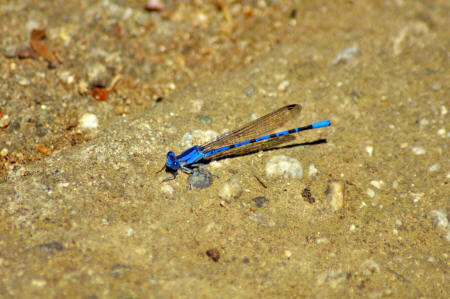|
Adult Male |
 |
|
Adult Female |
 |
|
|
Taxonomic Hierarchy |
|
Kingdom: |
Animalia -- animal |
|
Phylum: |
Arthropoda -- arthropods |
|
Class: |
hexapoda -- insects |
|
Subclass: |
Pterygota -- iwinged insects |
|
Infraclass: |
Palaeoptera-- wing insects |
|
Superorder: |
Odonatoptera -- ancient winged insects |
|
Order: |
Odonata -- Dragonflies and Damselflies |
|
Suborder: |
Zygoptera -- Damselflies |
|
Family: |
Coenagrionidae -- Narrow-winged
Damselflies |
|
Genus: |
Argia |
|
Species: |
Argia vivida |
|
|
Description: |
|
Diet: |
|
Naiad-This
is a small, but stocky naiad about ¾ inch (17 mm) long. The
coloration is mottled dark brown. |
|
Naiad-Naiads
eat a wide variety of aquatic insects, including mosquito
larvae, mayfly larvae, and other aquatic fly larvae. |
|
Adult-Male:
vivid blue & black markings; thorax top stripe has wide urn
shape; side thoracic stripe pinched at mid-length; middle
abdomen segment sides have small backwards pointing
arrow-shaped/triangular black streaks; blue tip surrounds
segments 8-10; when cool coloring becomes more purple;
immatures - milky gray
Adult-Female:
tan/gray & black or male-like |
Adult-Adults
eat a wide variety of small soft-bodied flying insects, such
as mosquitoes, mayflies, flies and small moths. They will
also pick small insects such as aphids from plants. |
|
Size: |
|
|
small/medium, length 30 - 40 mm |
|
|
Range Information: |
|
Habitat: |
|
This
species is found in eastern British Columbia and Alberta
south to Texas, New Mexico, and Baja California. |
|
This
damselfly is found at spring-fed streams, usually in arid or
semi-arid areas. |
|
U. S.
Flight
Season: |
|
California Flight Period: |
|
April 15
to October 25 |
|
capable
of flight whenever there is a prolonged warm spell |
|
Ecology: |
|
Reproduction: |
|
This
species is very closely associated with spring-fed streams,
and generally remains close to where it emerged. It probably
has the longest flight season of any dragonfly or damselfly
in our area. |
|
The
males set up territories at choice breeding sites. After
males and females mate, the male remains attached to the
female (called "in tandem") as she oviposits in vegetation
at spring-fed streams. |
|
Conservation: |
|
Sources : |
|
G1
G2
G3
G4
G5 |
|



|
|
G5 -
Populations are widespread, abundant, and secure.
|
|



